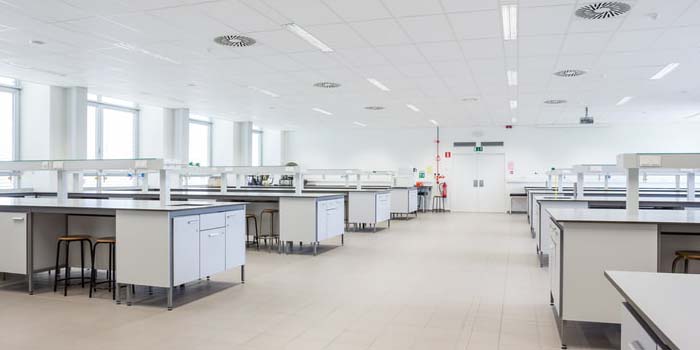6 Ways to Manage Risk When Planning a Lab Relocation
Performing a lab relocation requires careful planning and a strong team to find a new facility, move lab chemicals and high-stakes equipment, and thoroughly decontaminate your previous lab. Completing these tasks, among many others, while managing risks and ensuring your operation remains in compliance with federal, state, and municipal regulations can be a challenge. Without proper preparation and project management, the move could result in environmental risks, property damage, regulatory violations and fines, or even employee injury. Here are six tips to help manage risk so your lab relocation goes smoothly, whether your operation is currently planning a move or may be in the future.
1. Involve an EHS Manager or Consultant Early
It is important to consider all aspects of your lab relocation from an EHS perspective. Personnel without EHS experience may find a new space that seems to check all the boxes without realizing that it does not suit the nature of the lab operations, potentially leading to occupancy issues down the road or even safety risks to personnel. Lab facilities are not one-size-fits-all; depending on the nature of your research, your operation may have specific requirements in terms of location, size, and layout. An EHS manager or consultant can provide insight regarding these factors and more, such as shipping and receiving capabilities, HazMat flows, and material storage. By including an EHS professional in the early stages of project planning and as a main player on your relocation taskforce throughout the entire process, you can feel assured that your new lab space will be a good match for your operation.
2. Understand the State of Your New Space
When deciding on a new space, you will want to familiarize yourself with the previous operations that took place in the lab. Who was in the space before? What type of research did they do? Did they work with chemistry or biologics? What operations took place? Asking these questions, among others, can help you determine what potential contaminants may be left in a facility. To verify this, you can perform a confirmatory analysis to be sure the space is thoroughly decontaminated and safe for laboratory staff. Although receiving a comprehensive Decommission Report is standard and straightforward in most cases, requirements may be less obvious in the case of a sublease and should be reviewed carefully to ensure the space is safe and operational.
3. Include Internal and External Stakeholders
A strong project team should include both internal and external key stakeholders who can attend regular meetings to discuss the project plan, progress, and schedule. Internal stakeholders could include science department heads, IT, HR, or lab operators. These team leaders can help facilitate communication to their departments regarding responsibilities during the relocation process, timelines, and organization. Once you have looped in your internal stakeholders, you can identify gaps that can be filled by business partners and specialty vendors. These external stakeholders have specific expertise and experience in areas such as lab engineering, lab moves, biological decontamination, chemical moves, construction, plumbing, and reporting. Developing a regular meeting cadence that brings all your key stakeholders together, even weekly for extensive or complex projects, will keep communication lines open and ensure everyone is on the same page.
4. Ensure an Overlap Between Leases
To be safe, you should plan to have at least 30 days of overlap between your previous contract and your new lease. This allows for flexibility if, for instance, your previous lease requires you to surrender the property several weeks before the end of the contract. If you are doing construction in your new facility, you may need to obtain certificates of occupancy prior to your move. The overlap also provides a window of time for you to manage what you leave behind. What do you need to clear out of your space before handing the keys back over to the landlord? Be sure to assess any garbage or contaminants that should be cleared out at the end of your move.
5. Organize All Business Contracts, Permits, and Plans
Prior to your move, make sure any business contracts, including construction agreements, and certificates of occupancy are lined up to avoid any delays in starting your operations. Be sure to identify permits, licenses, and programs that apply to your facility’s science operations and consider what regulations govern those activities. Different towns, cities, and states have different regulations and requirements, so it is important to reach out to the proper regulatory agencies to ensure your lab operation is safe and in compliance. Some permits that you might need to obtain include a Flame Storage Permit or License, Source Registration, DEA Controlled Substances Registration, EPA ID for Hazardous Waste Generation, and Wastewater Discharge Permit.
6. Always Have a Plan B
Very few lab relocations go exactly as planned, even when the project team has prepared as much as possible. Strong, successful lab relocation teams can respond to adversity, pivot, and move forward. To do so, identify high risk areas of your operation such as finances or time conflicts and build contingencies into your plan.
Although lab relocation is a long process, moving does not need to be stressful. A proactive project team, good communication, and preparation are key in ensuring it goes smoothly. Triumvirate’s team of EHS industry experts are well-versed in every step of the lab relocation process. You can read about our lab relocation services here. Or click below to watch our recent webinar to learn more about Planning a Successful Lab and Facility Relocation.






